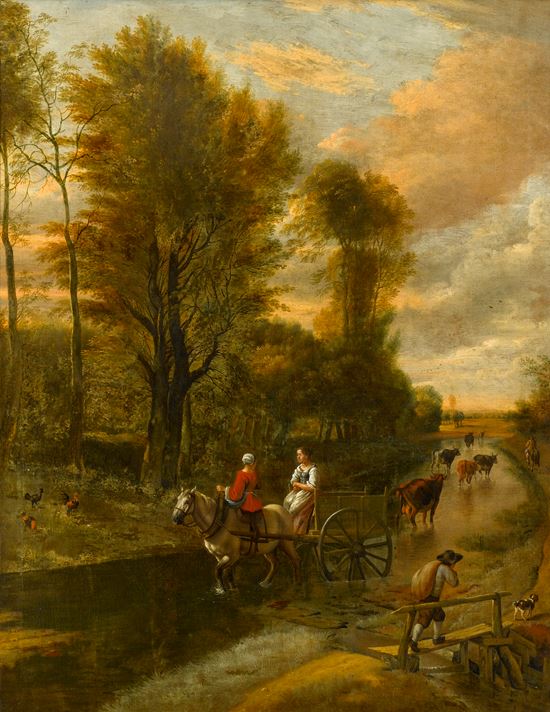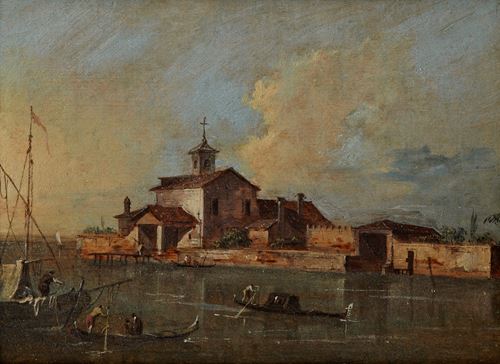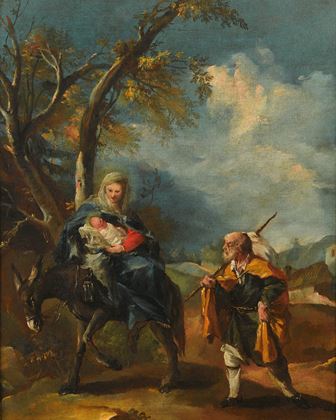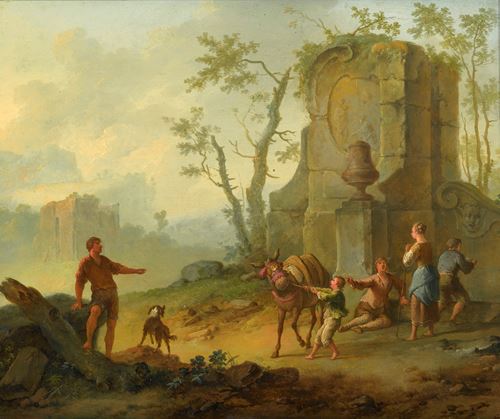an Siberechts
(Antwerp 1627 - London 1703)
A Horse-Drawn Cart with Two Women Travelling down a Flooded Road at the Edge of a Wood
signed and dated ‘J siberechts 1692’ (lower centre)
oil on canvas
126.5 x 99.7 cm (49¾ x 39¼ in)
Jan Siberechts’ A Horse-Drawn Cart with Two Women Travelling down a Flooded Road at the Edge of a Wood is a scene of the rustic English landscape. The water-logged path leads the eye across and back into the painting. On the far-side of the road is a wood, which encourages our eye further back into the distant landscape. Under the pink hue of the clouds, which suggests that it is dusk, a horse pulls a cart and two chattering women through the water at the end of the day. They have just passed cattle heading in the opposite direction, whose farmer rides alongside them. In the foreground, another peasant, lugging his heavy sack over a rickety bridge, follows behind his dog. As has been pointed out by Timon Fokker, Siberechts borrowed the distant landscape visible in the right background from an earlier picture now in the Museum of Fine Arts in Budapest that is signed and dated 1667.1
Siberechts painted the present painting in 1692, by which stage he had been living and working in England for many years. This painting is however dramatically different from his usual work of this period. Instead it follows in the tradition of the landscapes from his later Flemish period, which he occasionally still produced. By comparing A Horse-Drawn Cart with Two Women Travelling down a Flooded Road at the Edge of a Wood to a painting from his Flemish period, such as Peasants Crossing a Stream, which was executed over twenty years earlier, it becomes apparent that Siberechts has adopted the manner and style of the earlier work in the present painting. Both paintings have a stretch of water in the foreground on which Siberechts has indulged a clear interest in the glittering effects of light off the water’s surface. In both works the dominant figures are female, and the inclusion of cattle wading through the water are a prominent feature. The employment of the expanding distant landscape which leads our eye deep into the background of the work, is again a technique apparent in both paintings.
This idea of Siberechts returning to an earlier style becomes all the more apparent when one looks at work more typical of his time in England. Here he worked mainly for the English aristocracy, and many of his commissions were, what came to be regarded as the first country house portraits, one of the most famous examples being his View of Longleat, a work which seems to have very little in common with A Horse-Drawn Cart with Two Women Travelling Down a Flooded Road at the Edge of a Wood. The focus of the work is an accurate topographical depiction of the façade of the house at Longleat, still regarded as one of the finest examples of Elizabethan architecture in Britain. We are given a bird’s-eye view of the house from a central position, which gives us the best possible view of, not only the building, but also some of the surrounding estate. Here all the figures are minute, providing a sense of scale to the house, and those that are distinguishable are taking part in various leisure activities, such as walking about the grounds or hunting. This is in stark contrast to the focused images of peasant labour in the other two works thus far discussed. View of Longleat is an exercise in vanity on the part of Siberechts’ patron, Thomas Thynn, who wished to celebrate the magnificence of his house, which served as a reflection on his status and fortune, whereas in A Horse-Drawn Cart with Two Women Travelling Down a Flooded Road at the Edge of a Wood, Siberechts has given us an appreciative view of rural peasant life.
The son of a sculptor, Siberechts was born in 1627 and was baptised in Antwerp. He was apprenticed to the Flemish painter Adrian de Bie, and was elected to the Guild of St Luke in Antwerp in 1648. His earliest dated works show the impact of Dutch Italianate painters like Nicolaes Berchem and in fact he probably visited Italy in the late 1640s. Siberechts became a master in Antwerp in 1648 and his earliest dated works are stylistically akin to the paintings of the Dutch Italianate landscape painters. Around 1660, inspired by rustic life, he developed an individual style and started to paint Flemish scenes containing figures and animals. These landscapes, of which Peasants Crossing a Stream is an example, are regularly dominated by female figures dressed in simple clothing. Their bright whites, reds and yellows form colourful accents against the cool greens of the landscapes. Prominent rustic figures and animals are often further emphasised by patches of bright colour and dramatic lighting effects. Depicting figures with cattle crossing a stream bordered by large trees, is one of Siberechts’ recurring themes during this period. The backgrounds, which are generally cut off by an impenetrable, dull-coloured screen of foliage, emphasise the figures, animals and brightly lit road in the foreground. His works made until 1665 display an obvious interest in light effects. Thereafter, the representation of volume and shape became a predominant concern, expressed through, for example, more prominent figures placed sparingly in the foreground. He also opened up the curtain of trees characteristic of his earlier paintings, allowing trunks and branches to stand out as decorative features.
The predominant theme of Siberechts’ work of this early period is his depiction of noble peasants, like those in The Ford, which are often compared with those of France's Le Nain brothers. Possibly Siberechts drew inspiration for his noble portrayal from Brussels painter Michael Sweerts. Some of the motifs, such as the milkmaid carrying her heavy pail on her head, are reminiscent of counterparts in Rubens' late landscapes. Rubens’ influence was still keenly felt in Flemish landscape painting but Siberechts’ work is generally more original than that of those artists who worked in Rubens’ studio, such as Lucas van Uden and Jan Wildens. In the 1630s Antwerp genre painting was dominated by the style encapsulated by Adriaen Brouwer’s work. This is extremely focused, with the accent on violent drama expressed by a small number of figures, generally rough peasant types symbolic of unacceptable behaviour. However, artists such as Siberechts changed this attitude towards the countryside and his statuesque, almost heroic, peasant girls reflected the increasing demand, also prevalent in literary circles, for idyllic and pastoral subjects. The woman following her cattle in The Ford has an almost classical pose, and an almost sculptural stateliness which is notable in Siberechts’ figures, a reminder that his father was a sculptor. Marjorie Wieseman characterised the works of Siberechts in this period thus: 'As much figure and animal paintings as they are landscapes, Siberechts' views of watery highways are imbued with a quiet monumentality, expressed most cogently by the simple, solid forms of country folk and their livestock. With measured grandeur, they push against the resistance of the shallow water which slows and impedes their movement, raising the bright ripples and splashes which are a hallmark of the artist's work'.2
Siberechts arrived in England sometime between 1672 and 1674, apparently at the encouragement of George Villiers, 2nd Duke of Buckingham, who had seen some of Siberechts' landscapes in Antwerp in 1670, and Siberechts was immediately employed to help decorate the Duke’s residence at Cliveden, Buckinghamshire. Many of Antwerp’s leading artists emigrated during the seventeenth century and were not replaced, including David Teniers II who left to become court artist in Brussels, and by around 1700 the Antwerp school no longer existed. This was symptomatic of a wider trend, Siberechts being one of hundreds of Dutch and Flemish artists who came to Britain in the seventeenth century. He travelled extensively throughout his adopted country though the predominant oils of river landscapes which survive suggest that he concentrated on the topography of Derbyshire, the Trent, and the Thames valleys.
It was on arrival to England from Flanders that Siberechts started his career as a topographical painter, for which he is most noted, and he has long been regarded as the leading topographical painter of his day, although he also painted more generalised landscapes, particularly of the Peak District, merging his own style of Dutch influenced genre painting with the growing demands of country house portraiture. It was his reputation that attracted the patronage of men of the standing such as Thomas Thynn of Longleat, Sir Thomas Willoughby of Wollaton Hall, Philip Stanhope, 1st Earl of Chesterfield and William Cavendish, 1st Duke of Devonshire. As well as Longleat in 1675, his country house commissions included views of Chevely in 1681, Chatsworth in 1694 and Wollaton in 1695, creating topographically recognisable views of these buildings in more sober colour schemes than his earlier work. Longleat House is a fine example of Siberechts' ability to combine an accurate observation of topographical and architectural detail with a sensitive appreciation of the landscape of the extensive gardens and sweeping vistas of the surrounding countryside.
In these subjects, so much more aristocratic than his earlier work, Siberechts closely follows the form of composition which evolved earlier in France for military and topographical subjects and used repeatedly by painters such as Van der Meulen and the Martins. It is built up of three main elements: a very soft and atmospheric distance, in which the natural features were sometimes slightly falsified for the sake of the composition; a meticulously accurate rendering of the house itself in the middle distance; and more freely painted groups of riders, coaches, dogs and huntsmen in the foreground, which was usually steeply and artificially raised in order to justify the high point from which the house was drawn. Such canvases, formal though they are, foreshadow the more sophisticated views of English houses by Richard Wilson and Canaletto. Foreign artists had an enormous influence on English art of the period, in fact Siberechts’ undated View of Nottingham and the Trent (Collection of Lord Middleton, Birdsall House, Yorks.) is possibly among the earliest of British landscape paintings. The bird’s-eye view portrayal of houses with their estates, such as Longleat House, was introduced to England by Dutch artists and they dominated this new, fashionable style. Siberechts’ compatriot Jacob Knijff, with his brother Leonard Knijff, embarked in the 1690s on an ambitious project of drawing and engraving noblemen’s and gentlemen’s seats, beginning with those of John Holles, Duke of Newcastle. In 1701 Knijff announced that he had drawn 60 seats to date and that his series of engravings would eventually total 100. A large number of them appeared in Britannia Illustrata or Views of Several of the Queen’s Palaces, as also of the Principal Seats of the Nobility and Gentry of Great Britain (1707). This work was reissued in several volumes at various dates by a variety of publishers, sometimes with the title Nouveau théâtre de la Grande Bretagne, and the engravings were simultaneously marketed as independent prints. If we look at Knijff’s engraving of Longleat House, which was made in the early eighteenth century, we see that whilst still strictly topographical, the depictions of these grand country houses have become more inventive than the early works of Siberechts. The depiction is from a higher, more distant, less centralised angle than Siberechts’ painting with the result that as well as seeing more of the house, there is a greater emphasis on the extensive gardens and the estate as a whole. However, it is a work that owes a lot to Siberechts initial explorations into the genre.
As mentioned, during this period Siberechts still painted the occasional rural scene or landscape, such as A Horse-Drawn Cart with Two Women Travelling down a Flooded Road at the Edge of a Wood. He continued to use the same style that had matured in Flanders and he always saw the English countryside through Flemish eyes, although his style is quite independent of Rubens or the Brussels school. In these works and in Siberechts’ few surviving watercolours he was particularly interested in portraying mighty trees and soft light on distant hills, making the figures less important than the landscape. The viewer’s eye is drawn towards the broad, brightly lit vista in the background, while the foreground is kept relatively dark. Siberechts’ colour is cool and pleasant and his handling is broad. In England his subject-matter remained largely unchanged, but the distant scenery, which is used as a background for his troops of country folk with their horses, carts, and flocks, is recognisably English. Among the landscapes at Birdsall House, for example, which were painted for Sir Thomas Willoughby, is the Landscape with a Ford, in which a team of horses pull a wagon through the stream against a distant view of Wollaton House.
Having established a lucrative career in England, Siberechts remained here until his death in 1703. One of his daughters was a lace-maker for the Queen and another, Frances, married the sculptor John Nost. The influence of Siberechts can be seen in the work of a later generation of British landscape painters, including George Lambert and the early works of Thomas Gainsborough and, according to Sir Ellis Waterhouse, he has a claim to be regarded as the ‘father of British landscape’.3
1 T.H. Fokker, Jan Siberechts: Peintre de la Paysanne Flamande, Brussels, 1931, p.99.
2 Marjorie Wieseman, The Age of Rubens, exhibition catalogue, Boston 1993, p. 494, under no. 93
3 E. Waterhouse, Painting in Britain, 1530–1790, Harmondsworth, 1953, pp. 117–18.
Collection J. H. Leigh;
H. St. Barbe, Christie’s, London, 7th July 1916, lot 76 (£94 10s. to Haggins (?));
with J. Goudstikker, Amsterdam, 1918, where brought by the family of the previous owners in 1919 (Dfl. 5,500).
T.H. Fokker, Jan Siberechts: Peintre de la Paysanne Flamande, Brussels, 1931, p.99.
Jan Siberechts’ A Horse-Drawn Cart with Two Women Travelling down a Flooded Road at the Edge of a Wood is a scene of the rustic English landscape. The water-logged path leads the eye across and back into the painting. On the far-side of the road is a wood, which encourages our eye further back into the distant landscape. Under the pink hue of the clouds, which suggests that it is dusk, a horse pulls a cart and two chattering women through the water at the end of the day. They have just passed cattle heading in the opposite direction, whose farmer rides alongside them. In the foreground, another peasant, lugging his heavy sack over a rickety bridge, follows behind his dog. As has been pointed out by Timon Fokker, Siberechts borrowed the distant landscape visible in the right background from an earlier picture now in the Museum of Fine Arts in Budapest that is signed and dated 1667.1
Siberechts painted the present painting in 1692, by which stage he had been living and working in England for many years. This painting is however dramatically different from his usual work of this period. Instead it follows in the tradition of the landscapes from his later Flemish period, which he occasionally still produced. By comparing A Horse-Drawn Cart with Two Women Travelling down a Flooded Road at the Edge of a Wood to a painting from his Flemish period, such as Peasants Crossing a Stream, which was executed over twenty years earlier, it becomes apparent that Siberechts has adopted the manner and style of the earlier work in the present painting. Both paintings have a stretch of water in the foreground on which Siberechts has indulged a clear interest in the glittering effects of light off the water’s surface. In both works the dominant figures are female, and the inclusion of cattle wading through the water are a prominent feature. The employment of the expanding distant landscape which leads our eye deep into the background of the work, is again a technique apparent in both paintings.
This idea of Siberechts returning to an earlier style becomes all the more apparent when one looks at work more typical of his time in England. Here he worked mainly for the English aristocracy, and many of his commissions were, what came to be regarded as the first country house portraits, one of the most famous examples being his View of Longleat, a work which seems to have very little in common with A Horse-Drawn Cart with Two Women Travelling Down a Flooded Road at the Edge of a Wood. The focus of the work is an accurate topographical depiction of the façade of the house at Longleat, still regarded as one of the finest examples of Elizabethan architecture in Britain. We are given a bird’s-eye view of the house from a central position, which gives us the best possible view of, not only the building, but also some of the surrounding estate. Here all the figures are minute, providing a sense of scale to the house, and those that are distinguishable are taking part in various leisure activities, such as walking about the grounds or hunting. This is in stark contrast to the focused images of peasant labour in the other two works thus far discussed. View of Longleat is an exercise in vanity on the part of Siberechts’ patron, Thomas Thynn, who wished to celebrate the magnificence of his house, which served as a reflection on his status and fortune, whereas in A Horse-Drawn Cart with Two Women Travelling Down a Flooded Road at the Edge of a Wood, Siberechts has given us an appreciative view of rural peasant life.
The son of a sculptor, Siberechts was born in 1627 and was baptised in Antwerp. He was apprenticed to the Flemish painter Adrian de Bie, and was elected to the Guild of St Luke in Antwerp in 1648. His earliest dated works show the impact of Dutch Italianate painters like Nicolaes Berchem and in fact he probably visited Italy in the late 1640s. Siberechts became a master in Antwerp in 1648 and his earliest dated works are stylistically akin to the paintings of the Dutch Italianate landscape painters. Around 1660, inspired by rustic life, he developed an individual style and started to paint Flemish scenes containing figures and animals. These landscapes, of which Peasants Crossing a Stream is an example, are regularly dominated by female figures dressed in simple clothing. Their bright whites, reds and yellows form colourful accents against the cool greens of the landscapes. Prominent rustic figures and animals are often further emphasised by patches of bright colour and dramatic lighting effects. Depicting figures with cattle crossing a stream bordered by large trees, is one of Siberechts’ recurring themes during this period. The backgrounds, which are generally cut off by an impenetrable, dull-coloured screen of foliage, emphasise the figures, animals and brightly lit road in the foreground. His works made until 1665 display an obvious interest in light effects. Thereafter, the representation of volume and shape became a predominant concern, expressed through, for example, more prominent figures placed sparingly in the foreground. He also opened up the curtain of trees characteristic of his earlier paintings, allowing trunks and branches to stand out as decorative features.
The predominant theme of Siberechts’ work of this early period is his depiction of noble peasants, like those in The Ford, which are often compared with those of France's Le Nain brothers. Possibly Siberechts drew inspiration for his noble portrayal from Brussels painter Michael Sweerts. Some of the motifs, such as the milkmaid carrying her heavy pail on her head, are reminiscent of counterparts in Rubens' late landscapes. Rubens’ influence was still keenly felt in Flemish landscape painting but Siberechts’ work is generally more original than that of those artists who worked in Rubens’ studio, such as Lucas van Uden and Jan Wildens. In the 1630s Antwerp genre painting was dominated by the style encapsulated by Adriaen Brouwer’s work. This is extremely focused, with the accent on violent drama expressed by a small number of figures, generally rough peasant types symbolic of unacceptable behaviour. However, artists such as Siberechts changed this attitude towards the countryside and his statuesque, almost heroic, peasant girls reflected the increasing demand, also prevalent in literary circles, for idyllic and pastoral subjects. The woman following her cattle in The Ford has an almost classical pose, and an almost sculptural stateliness which is notable in Siberechts’ figures, a reminder that his father was a sculptor. Marjorie Wieseman characterised the works of Siberechts in this period thus: 'As much figure and animal paintings as they are landscapes, Siberechts' views of watery highways are imbued with a quiet monumentality, expressed most cogently by the simple, solid forms of country folk and their livestock. With measured grandeur, they push against the resistance of the shallow water which slows and impedes their movement, raising the bright ripples and splashes which are a hallmark of the artist's work'.2
Siberechts arrived in England sometime between 1672 and 1674, apparently at the encouragement of George Villiers, 2nd Duke of Buckingham, who had seen some of Siberechts' landscapes in Antwerp in 1670, and Siberechts was immediately employed to help decorate the Duke’s residence at Cliveden, Buckinghamshire. Many of Antwerp’s leading artists emigrated during the seventeenth century and were not replaced, including David Teniers II who left to become court artist in Brussels, and by around 1700 the Antwerp school no longer existed. This was symptomatic of a wider trend, Siberechts being one of hundreds of Dutch and Flemish artists who came to Britain in the seventeenth century. He travelled extensively throughout his adopted country though the predominant oils of river landscapes which survive suggest that he concentrated on the topography of Derbyshire, the Trent, and the Thames valleys.
It was on arrival to England from Flanders that Siberechts started his career as a topographical painter, for which he is most noted, and he has long been regarded as the leading topographical painter of his day, although he also painted more generalised landscapes, particularly of the Peak District, merging his own style of Dutch influenced genre painting with the growing demands of country house portraiture. It was his reputation that attracted the patronage of men of the standing such as Thomas Thynn of Longleat, Sir Thomas Willoughby of Wollaton Hall, Philip Stanhope, 1st Earl of Chesterfield and William Cavendish, 1st Duke of Devonshire. As well as Longleat in 1675, his country house commissions included views of Chevely in 1681, Chatsworth in 1694 and Wollaton in 1695, creating topographically recognisable views of these buildings in more sober colour schemes than his earlier work. Longleat House is a fine example of Siberechts' ability to combine an accurate observation of topographical and architectural detail with a sensitive appreciation of the landscape of the extensive gardens and sweeping vistas of the surrounding countryside.
In these subjects, so much more aristocratic than his earlier work, Siberechts closely follows the form of composition which evolved earlier in France for military and topographical subjects and used repeatedly by painters such as Van der Meulen and the Martins. It is built up of three main elements: a very soft and atmospheric distance, in which the natural features were sometimes slightly falsified for the sake of the composition; a meticulously accurate rendering of the house itself in the middle distance; and more freely painted groups of riders, coaches, dogs and huntsmen in the foreground, which was usually steeply and artificially raised in order to justify the high point from which the house was drawn. Such canvases, formal though they are, foreshadow the more sophisticated views of English houses by Richard Wilson and Canaletto. Foreign artists had an enormous influence on English art of the period, in fact Siberechts’ undated View of Nottingham and the Trent (Collection of Lord Middleton, Birdsall House, Yorks.) is possibly among the earliest of British landscape paintings. The bird’s-eye view portrayal of houses with their estates, such as Longleat House, was introduced to England by Dutch artists and they dominated this new, fashionable style. Siberechts’ compatriot Jacob Knijff, with his brother Leonard Knijff, embarked in the 1690s on an ambitious project of drawing and engraving noblemen’s and gentlemen’s seats, beginning with those of John Holles, Duke of Newcastle. In 1701 Knijff announced that he had drawn 60 seats to date and that his series of engravings would eventually total 100. A large number of them appeared in Britannia Illustrata or Views of Several of the Queen’s Palaces, as also of the Principal Seats of the Nobility and Gentry of Great Britain (1707). This work was reissued in several volumes at various dates by a variety of publishers, sometimes with the title Nouveau théâtre de la Grande Bretagne, and the engravings were simultaneously marketed as independent prints. If we look at Knijff’s engraving of Longleat House, which was made in the early eighteenth century, we see that whilst still strictly topographical, the depictions of these grand country houses have become more inventive than the early works of Siberechts. The depiction is from a higher, more distant, less centralised angle than Siberechts’ painting with the result that as well as seeing more of the house, there is a greater emphasis on the extensive gardens and the estate as a whole. However, it is a work that owes a lot to Siberechts initial explorations into the genre.
As mentioned, during this period Siberechts still painted the occasional rural scene or landscape, such as A Horse-Drawn Cart with Two Women Travelling down a Flooded Road at the Edge of a Wood. He continued to use the same style that had matured in Flanders and he always saw the English countryside through Flemish eyes, although his style is quite independent of Rubens or the Brussels school. In these works and in Siberechts’ few surviving watercolours he was particularly interested in portraying mighty trees and soft light on distant hills, making the figures less important than the landscape. The viewer’s eye is drawn towards the broad, brightly lit vista in the background, while the foreground is kept relatively dark. Siberechts’ colour is cool and pleasant and his handling is broad. In England his subject-matter remained largely unchanged, but the distant scenery, which is used as a background for his troops of country folk with their horses, carts, and flocks, is recognisably English. Among the landscapes at Birdsall House, for example, which were painted for Sir Thomas Willoughby, is the Landscape with a Ford, in which a team of horses pull a wagon through the stream against a distant view of Wollaton House.
Having established a lucrative career in England, Siberechts remained here until his death in 1703. One of his daughters was a lace-maker for the Queen and another, Frances, married the sculptor John Nost. The influence of Siberechts can be seen in the work of a later generation of British landscape painters, including George Lambert and the early works of Thomas Gainsborough and, according to Sir Ellis Waterhouse, he has a claim to be regarded as the ‘father of British landscape’.3
1 T.H. Fokker, Jan Siberechts: Peintre de la Paysanne Flamande, Brussels, 1931, p.99.
2 Marjorie Wieseman, The Age of Rubens, exhibition catalogue, Boston 1993, p. 494, under no. 93
3 E. Waterhouse, Painting in Britain, 1530–1790, Harmondsworth, 1953, pp. 117–18.
Collection J. H. Leigh;
H. St. Barbe, Christie’s, London, 7th July 1916, lot 76 (£94 10s. to Haggins (?));
with J. Goudstikker, Amsterdam, 1918, where brought by the family of the previous owners in 1919 (Dfl. 5,500).
T.H. Fokker, Jan Siberechts: Peintre de la Paysanne Flamande, Brussels, 1931, p.99.




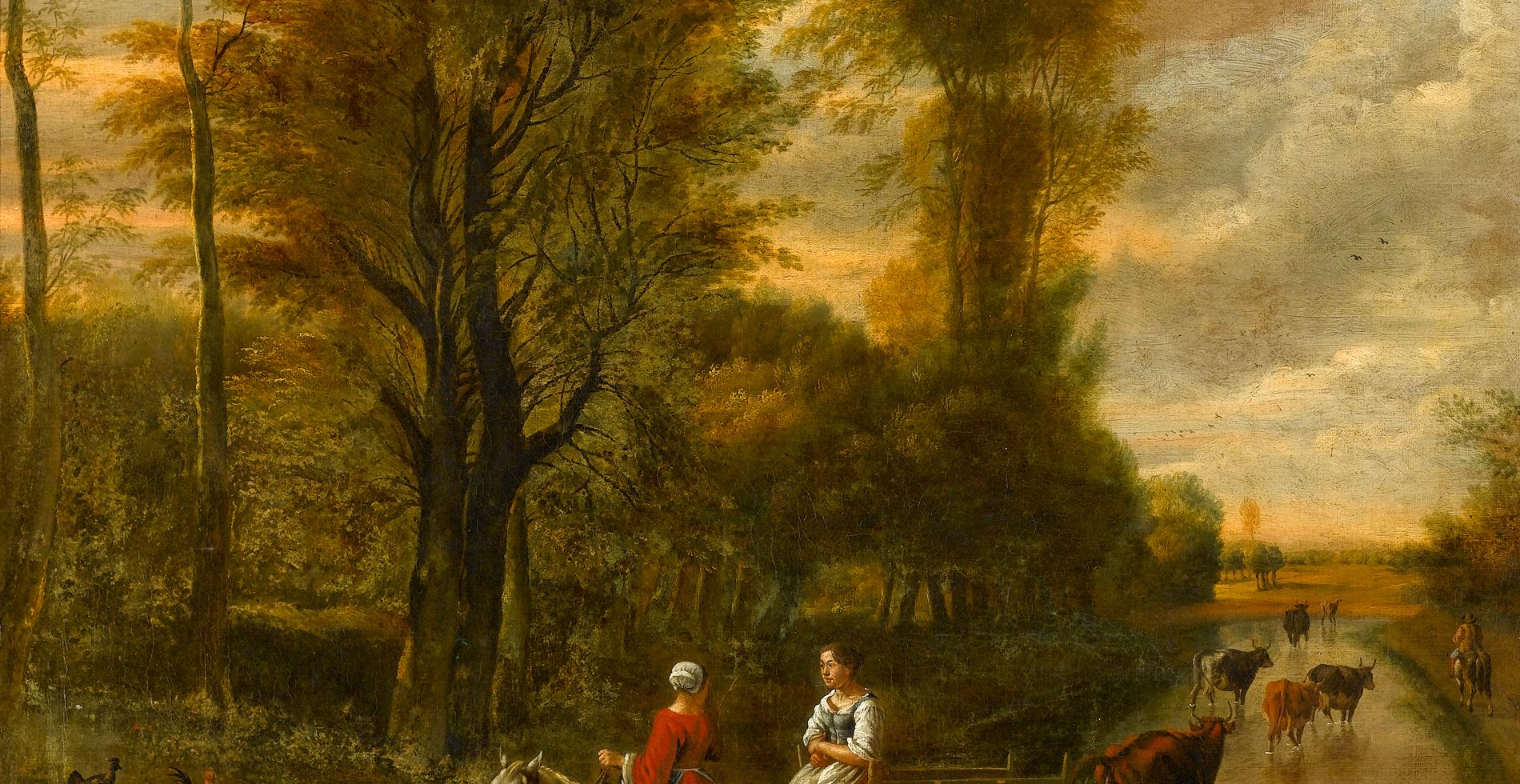
 contact
contact +44 20 7313 8040
+44 20 7313 8040


